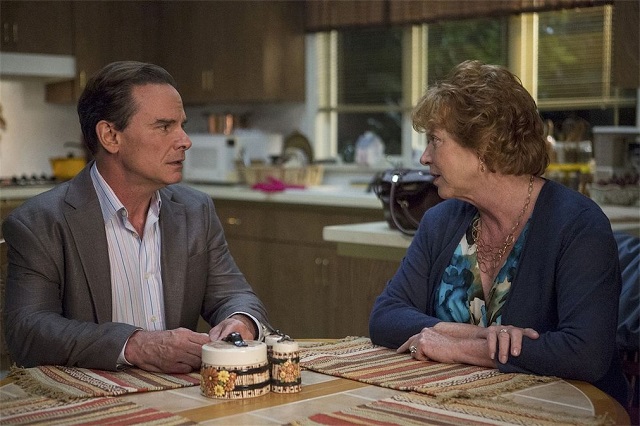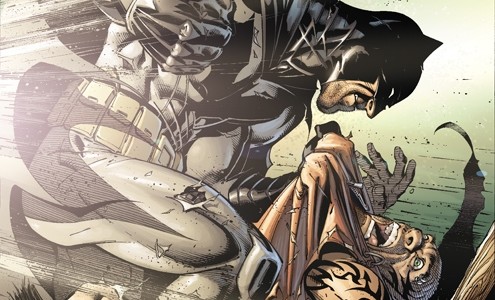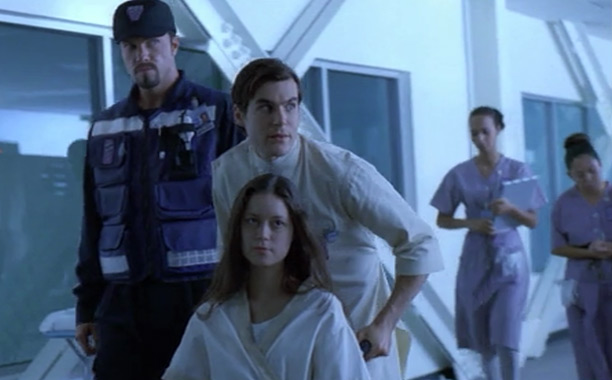Finding Nemo encompasses a tremendous amount of positive imagery that makes up Disney and Pixar’s populous appeal. From learning how to trust family and friends, to overcoming biggest fears and obstacles, Finding Nemo understands how to tap into the audience’s heartstrings and neatly ties in a meaningful message for the viewer to take home. Yet with every good side, there is a dark presence that even Disney can’t back away from. Like many Disney films, from Bambi to Frozen, Finding Nemo deals with a story whose basis stems from a broken household struggling with a great deal of separation. Why does Disney cling onto threads of such despair and heartache? Perhaps it’s a factor many can relate to. Or perhaps it’s a working formula that sweetens the arc of a happy ending. Either way, separation is a tapped fountain of which Hollywood has dipped into time after time again. Whether it’s Disney or Hitchcock, separation has been reenacted in various degrees on the big screen. The following are a few films that have proven to demonstrate it on par of that to Finding Nemo. As devastating as separation can be, Disney’s common tropes can be seen in a numerous amount of films, whether it’s in the form of remakes or concepts for other original stories. In the end, everyone finds his or her way home.
- The Brave Little Toaster, by Jerry Rees. The 1987 animated comedy by Disney was adapted by Thomas Disch’s 1980 novel, The Brave Little Toaster: A Bedtime Story For Small Appliances. Set in a world where household appliances can speak and move, pretending to be lifeless in the presence of humans, the story follows five gizmos – a toaster (Deanna Oliver), a lamp (Timothy Stack), an electric blanket (Timothy Day), a radio (Jon Lovitz) and a vacuum cleaner (Thurl Ravenscroft) – as they are abandoned in a cabin by their beloved owner Rob (Wayne Kaatz). After trying to find their way back to Rob, the appliances manage to avoid drowning in mud holes, being disassembled and sold in a nearby part store, and pursued by a menacing magnetic crane in a junkyard. After finding Rob, who is on his way to college, in the junkyard, the group manages to foil an evil crane and return to their faithful owner. Sound familiar? If you replace appliances with toys, Toy Story comes to mind, which is no surprise since John Lasseter and Joe Ranft worked on the film prior to working at Pixar Animation Studios. Later, Lasseter and Ranft worked together on all Pixar features up to Ranft’s untimely death in 2006. Such films include Toy Story, A Bug’s Life, and even Finding Nemo. The Brave Little Toaster was a hit on home video and was followed by two sequels a decade later (The Brave Little Toaster Goes to Mars and The Brave Little Toaster to the Rescue).

- The Incredible Journey, by Fletcher Markie. The Incredible Journey is a 1963 live-action Walt Disney film based on the novel, The Incredible Journey, by Sheila Burnford. Narrated by Rex Allen, the film follows the adventure of three pets, Luath the Labrador Retriever, Bodger the Bull Terrier, and Tao the Siamese cat, as they journey 250 miles through the Canadian wilderness to return to their home. In 1993, the film was remade and titled Homeward Bound: The Incredible Journey, starring Michael J. Fox, Sally Fields, and Don Ameche, grossing $42 million worldwide and inspiring a sequel. Some of the changes include the name change of all three pets, the sex of the cat, and the ages of the Labrador and Bull Terrier. If we take it a step further and switch furry to aquarium pets, we can see the basis for Finding Nemo emerge. Call it homage or rip-off, the plotline – pets get lost, pets go on an adventure to find home, pets get home – makes for a compelling hit. Whether it’s 1963, 1993, 2003 or later – the story of lost and found pets never gets old.

- The Wizard of Oz, by Victor Fleming. There is no denying that the film is about separation and finding Dorothy’s way back to Kansas, because after all, “There is no place like home.” Even with its common premise, a more notable thread between Oz and Nemo is in its technical achievements. For Oz, Technicolor virtually set the color standard for filmmaking. To take advantage of the new vivid Technicolor process, Dorothy’s silver shoes from the book were changed to ruby slippers for the movie. For Nemo, water animation was so realistic, that by stylizing the design, adding more geometry, and pushing color saturation, the film became more caricaturized for a cartoon animation.

- Kill Bill (Vol. 2), by Quentin Tarantino. Surely, the Tarantino chop suey cult classic is far more a revenge piece than anything else. Yet, as the film’s main character, Beatrix (Uma Truman), finds out that the daughter that was taken from her from birth is still alive, the film ultimately gains a bit more gravitas in establishing itself within the rescue genre.

- Flightplan, by Robert Schwentke. This 2005 thriller tells the story of Kyle Pratt (Jodie Foster), an aircraft engineer traveling to Long Island with her daughter Julia to bury her late husband. The film is loosely based on the 1938 Hitchcock classic The Lady Vanishes, with the added element of family drama. After falling asleep onboard the plane, Kyle wakes to find that Julia is missing. None of the passengers remember seeing her daughter, and she isn’t registered in either the airport or the passenger manifest. To everyone else, Julia does not exist. The crew members suspect that Kyle has become unhinged by her husband’s death, and has imagined bringing her daughter aboard. Although received with mixed reviews, the film made nearly $90 million worldwide and has been described by Roger Ebert as “a frightening thriller with an airtight plot.” The prevailing element here, amongst many lost and found films like Finding Nemo, is that of fear and panic. Like Kyle and Marlin, with separation for a child, only comes a parent’s natural reaction to expect the worse. That buildup can only bring about a satisfying climax to any mystery.

- E.T. The Extra-Terrestrial, by Steven Spielberg. Right up there with The Wizard of Oz, Spielberg’s masterpiece is by far one of the more familiar films on this list. And yet, E.T. has the most personal connection to separation with its director: Spielberg drew the story from his parents’ divorce. Gary Arnold of The Washington Post called the film “essentially a spiritual autobiography, a portrait of the filmmaker as a typical suburban kid set apart by an uncommonly fervent, mystical imagination.” Parallels have been drawn between E.T. and the film’s main character Elliot (Henry Thomas), who is alienated and ostracized by the loss of his father. Elliot, like E.T., is desperate to find a place in his life that he can call home. At its core, the film is about growing up and coming of age. And just like Finding Nemo, with loss and abandonment comes a rebirth and recognition of self-worth.

- Elf, by Jon Favreau. Essentially, this is the reversal of Finding Nemo, about a son trying to find his father. The film captures the essence of being a fish-out-of-water story. The story is about one of Santa’s elves, Buddy (Will Ferrell) who learns of his true identity as a human and goes to New York City to meet his biological father (James Caan), spreading Christmas cheer in a world of cynics as he goes. What deviates this tale from that of other finding identity films is that everyone around Buddy has something to learn and change about himself or herself more than our protagonist. Due to his flawless innocence, Buddy is the quintessence of self-worth and recognition. Like Marlin, it’s up to Walter to discover the power of trusting his own son to grow stronger as a father.

- Bambi, by David Hand. This is the definition of abandonment and finding one’s way and understanding of home. During Bambi’s first winter, a deer hunter, leaving the little fawn mournful and alone, kills his mother. Taking pity on his abandoned son, the Great Prince leads him home. Years later, Bambi has matured into a young stag, eventually taking on the title of Great Prince of the Forest. With his understanding of loss comes a profound sense of maturity. Like Nemo, the struggle of Bambi’s journey leads to greater self-acquisition when reaching his destiny.

- Home Alone 2: Lost in New York, by Chris Columbus. This John Hughes-written film is probably closer akin to the premise of Finding Nemo than any other other film on this list. Mother (Catherine O’Hara) loses son (Macaulay Culkin), son gets into trouble and lost in a city far away from home, mother finds son. The power of both films relies heavily on its core message that a parent’s love conquers any distance and danger.

- Taken, by Pierre Morel. Seemingly the farthest stretch from Finding Nemo, Taken has more similarities to the 2003 film than one might think. Sure, there is the element of separation and a father’s drive to rescue and protect his child at all costs and dangers, but there is more to unfold. Both dads are single: Marlin a widower and Bryan (Liam Neeson) is divorced. Marlin is very overprotective and doesn’t want Nemo to go to the drop-off. Bryan is also overprotective and doesn’t want his daughter Kim (Maggie Grace) to go to Paris. During their journey to find their missing child, Marlin encounters sharks, while Bryan escapes from criminals. Both go on a mission trip far away from home. Bryan goes to Paris, while Marlin seeks out Sydney. Despite all that they encounter, in the end, everything boils down to the same premise: what starts out as a horrific abduction, ends up being a climactic reunion of parent and child.
– Christopher Clemente








